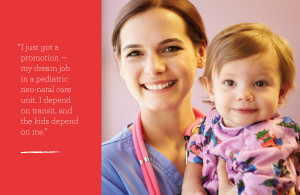 CMT hosted the Livability Matters: Transportation Choice & Connections this Thursday in partnership with AARP in St. Louis, the St. Louis Regional Chamber and East-West Gateway Council of Governments.
CMT hosted the Livability Matters: Transportation Choice & Connections this Thursday in partnership with AARP in St. Louis, the St. Louis Regional Chamber and East-West Gateway Council of Governments.
Why is CMT talking livability? Transportation choices and connections go hand in hand with the livability of a region, and we know a safe, reliable and efficient transit system can impact the opportunities for all residents in the St. Louis region.
So why does livability matter? Every city wants to be considered the “most livable,” a title that can help attract new business and investments, boost local economies and real estate, and foster community involvement and pride. It can impact how people relate to each other, the opportunity to form community, and the depth of our social networks. A livable city can impact how much exercise is possible through walking and biking. It can help to reduce crime with more eyes on the street, and tt can directly impact a region’s bottom line.
 So how does transit impact livability? Beyond the trip from Point A to Point B, transit investment can impact the bottom line of any region or state.
So how does transit impact livability? Beyond the trip from Point A to Point B, transit investment can impact the bottom line of any region or state.
- Transit is a sound investment for this region. Every dollar spent on transit has a $4 return for the region. Every $10 million in capital investment in public transit yields $30 million in increased business sales, and every $1 billion invested in public transportation supports and helps create more than 50,000 jobs. Further, statistics show homes located near public transportation with high-frequency service are valued 42 percent higher. In St. Louis there has been at least $16 billion in new development within a 10 minute walk of transit stations since MetroLink’s opening in 1993. It makes good business sense to invest in transit.
- Transit provides a cost-savings. The average St. Louis and Kansas City household spends nearly 20 percent of its budget on transportation. According to HUD, median income households with two commuters in St. Louis spend 19 percent of their income on transportation. A low-income individual spends up to 40 percent of their income on transportation. Transit as an option reduces this cost percentage significantly. Putting more revenues back in residents’ pockets puts more revenue back in the economy.
- Transit is a tool to increase personal wealth. A recent study by Transportation for America commissioned by CMT notes that our region does not do enough to connect people to opportunity especially through transit. A Brookings Institution report comparing 100 metro areas of similar size, highlighted that only 24 percent of jobs can be accessed within a 90 minute transit trip in the St. Louis region. This is an opportunity for businesses to get on board with transit to impact the livability of this region. The Center for Neighborhood Technology (CNT)[2] found that, when looking for a place to live, considering housing and transportation costs together changes the picture of affordability significantly. In one of many studies CNT was involved in, the transportation costs savings from locating near transit outweighed the higher housing cost of living near transit, thus freeing up money to invest in appreciating assets, like an education or a home.
- Transit is a tool to gain and retain a quality workforce. State Farm, one of the country’s largest insurance companies, is betting big on transit in three cities by building or expanding regional hubs on sites with good access to public transportation, reflecting a clear strategy to attract and retain talent who increasingly want to live and work in locations connected by transit.“We’re designing these workplaces to be the future of State Farm,” chief operating officer Michael Tipsord said. “We’re creating a live-work-play environment that will give employees easy access to their work from the neighboring communities.” The new hub in Tempe will give State Farm enough space to expand their Phoenix-area workforce from 4,500 to more than 8,000, and will be a ten-minute walk from a Valley Light Rail stop right by Sun Devil stadium at the edge of the Arizona State University campus.
In 2015, the Ferguson Commission released the Forward through Ferguson report. The report focused primarily on racial inequity, but also recognized more generally that “A safe, reliable, affordable, and efficient public transportation system can increase access to health care, education, and employment,” and that “Public transit is a key to expanding opportunity for all St. Louisans.”
The two specific calls to action regarding transportation highlighted were:
- Develop a State Supported Funding Plan for Public Transit,
- Identify Priority Transportation Projects for the St. Louis Region
Right now, Missouri ranks 44th out of 50 states in public transit funding, and spends just 9 cents per capita on public transportation. Our neighbor, Illinois, spends $66.30 per capita. This is an opportunity for the region and the state to do more for transit.
Currently 75 percent of the transit rides in this region are employment related and 20 percent are education related (Bi-State Development). A fundamental shift on the part of the private sector to support transit could go a long way to increasing livability in this region through transit.
A perfect example of the private sector supporting and thus successfully expanding transit is the Cortex Station. Corporate and public sector partners including Cortex, Washington University, BJC Healthcare, Great Rivers Greenway and the St. Louis Development Corporation provided 33.1 percent of the funding ($4.7 million) to make a new light rail station at CORTEX a reality. Their support — along with CMT’s leadership on securing a grant to conduct the required feasibility study — led to Metro’s ability to secure a $10.3 million federal grant to build a new MetroLink station, expand the CWE Station, and create a bike-pedestrian connector.
In addition, the St. Louis Regional Chamber has made transit one of its key priorities in its Regional Agenda for Prosperity.
Transit is this region’s opportunity to create a livable community for the future. Next steps need to include a transit funding plan, priority projects for this region to coalesce around, and private sector support of transit expansion.